Alto Adige tasting
72 good wines.
72 good wines.
There’s still a lot of bad wine made under that name (drive from Verona to Vicenza and you’ll see hundreds of hectares under vine on the flat fertile clays by the railway line). Yet to dismiss Soave altogether would be a grave mistake. In fact, I consider it one of Italy’s leading appellations. This is thanks to some inherently great terroirs (predominantly volcanic tuff) and a generation of hard-working vintners that have elevated the DOC to its deserved glory: Suavia, Tamellini, Prà, Gini, Inama.
And then there is
Leonildo Pieropan, Soave’s patriarch making brilliant wines since the 1970s. His Calvarino and La Rocca crus (the latter the first Soave to age in new French oak) are benchmarks for Italian white wine. It’s always intersting to try the old man’s new vintages, so I was happy to pull the corks from the two following bottles.The Soave Classico 2007 is, in short, a relative disappointment. It shows a vague Soave typicity of raw apple, diluted lemony crispness, and nominal reductive minerality, but it’s really a simple and unassuming creature. Same on the palate, juicy with no special length or depth. It remains a reliable wine, at least European-poised and refreshing and terroir-driven, but I just expect more fireworks from the name Pieropan on the label. It’s consistent with the latest vintages of this bottling: I think some new vineyards were introduced and the production increased, and perhaps this drop in stature and structure is inevitable until these new plantings grow older.
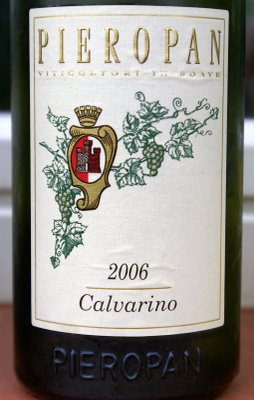 The Soave Classico Calvarino 2006, on the other hand, shows Pieropan in excellent shape. It drinks very well over three days and shows a real sense of place. Not overwhelmingly intense but has a strong mineral and acidic backbone that does wonders with food. Quite saline and active – this is real minerality, perhaps at the expensive of fruit which is much in the background (apple). Contrary to my expectations and despite coming from a warm, low-acid vintage this is everything but flabby. That’s clearly thanks to a 30% of the Trebbiano di Soave grape (the rest is Soave’s flagship grape, Gargànega), long despised for its low ripeness and aroma but now back in favour for the strong acidity (not to say greenness, as in this case) and minerality it lends to Soave wines. And it also lowers the alcohol – this wine is only 12.5%. An excellent bottle that needs a year or two more before peaking.
The Soave Classico Calvarino 2006, on the other hand, shows Pieropan in excellent shape. It drinks very well over three days and shows a real sense of place. Not overwhelmingly intense but has a strong mineral and acidic backbone that does wonders with food. Quite saline and active – this is real minerality, perhaps at the expensive of fruit which is much in the background (apple). Contrary to my expectations and despite coming from a warm, low-acid vintage this is everything but flabby. That’s clearly thanks to a 30% of the Trebbiano di Soave grape (the rest is Soave’s flagship grape, Gargànega), long despised for its low ripeness and aroma but now back in favour for the strong acidity (not to say greenness, as in this case) and minerality it lends to Soave wines. And it also lowers the alcohol – this wine is only 12.5%. An excellent bottle that needs a year or two more before peaking.
Two wines that caught my attention, though, are a white and a red made fully without the addition of sulphur. There is currently a (justified) fashion towards organic and biodynamic wines, but even biodynamics is not necessarily synonymous with no sulphur addition. Sulphur (usually in the form of sulphur dioxide; hence the Contains sulphites mention on wine bottles now obligatory in the EU) is considered a ‘traditional’ additive to wine, and has been used for centuries to protect from bacteria and oxidation. These two factors make no-sulphur-added wines (there is always a bit of sulphur naturally produced during fermentation) a challenge. With low SO2, your wine is prone to all sorts of bacteria including acetic bacteria that change wine into vinegar (with no SO2, this is handled by extreme hygiene in the cellar, and keeping wine at low temperatures throughout – not always easy for shops and consumers) and is likely to oxidise if exposed to air for too long (which is why you are usually advised to drink a no-sulphur wine in one session and avoid decanting, though there are some exceptions).
You will find a growing range of interesting low- or no-sulphur wines from Alsace, Beaujolais, the Loire, but very few from Italy, where the concept has been establishing itself more slowly. That’s the background of my interest in trying these wines. Both are from 2008 and are classified in the umbrella DOC Langhe.
The white Di Vin Natura 2008, a blend of Sauvignon Blanc with local Arneis, is forgettable: showing a good saline intensity of terroir in mouth, it just lacks fruit, and the nose is fairly chaotic, reminiscent of of home-made ‘wine’ with all sorts of yeasty, microbial aromas. The red Di Vin Natura 2008 (blended from Nebbiolo, Barbera, Cabernet and Melot), on the other hand, is really interesting. It too displays a rustic just-finished-fermentation nose (aroma is rarely a biodynamic wine’s strength) but on the palate there is a moment of blissful fruit intensity of the kind you almost never encounter in a ‘normal’ wine.
Sulphur puts a wine in order: it is like packing a porcelain vase for shipping. It stabilises, immobilises, and to an extent, standardises. But it does so by putting a layer of matt varnish over the fruit. We get a lot from sulphur – a vast majority of our wines would be undrinkable without – but need to give up something in exchange: this unadulterated, tangible, pulsating presence of fruit flesh. If you’re feeling nostalgic about this loss, no-sulphur wines are for you.
Went to a friend’s house recently to go through a shipment of samples he received from Gambellara, an appellation from the Italian region of Veneto that was recently awarded a DOCG status.
DOCG is supposed to be a notch above denominazione di origine controllata (DOC, Italy’s appellation of wine origin, equivalent to France’s AOC), although the exact difference is somewhat vague and the ‘G’ of garantita is hardly ever a guarantee of anything. There are currently 34 DOCGs in Italy including classic winemaking zones such as Barolo and Chianti Classico but also some rather puzzling nominations such as Albana di Romagna, an obscure and underperforming white wine zone east of Bologna.
Gambellara consists of 800 hectares of withered volcanic basalt located on extinct volcanoes between Verona and Vicenza in north-eastern Italy. Its whites wines – traditionally sweet passito from dried grapes, and now increasingly dry – are made of the Gargànega grape variety, and are in fact a lesser sibling of the better-known Soave, one of Italy’s classic whites made from exactly the same grape and on similar terroir.
I really, really like Soave and think it is one of the most underrated wines in Italy (today, thanks to the efforts of a dynamic group of vintners, it increasingly lives up to its potential). So I approached this tasting in a positive mood, but was vastly disappointed. We tasted 16 wines (10 dry, 6 sweet) that were all on a disastrously boring commercial level with no interest whatsoever.
Gargànega is not easy grape. It takes an expressive terroir and low yields to show good intensity, and the winemaking style needs to avoid extremes of technicity (bland ‘white-winey’ wines tasting like a million cool-vinified chardonnays or pinots) and oak (which can easily obscure the varietal character). On an everyday level, Gargànega can deliver a vaguely almondy, appley-crisp white with a hint of mineral salinity that is an unpretentious delight with lighter foods, but even that needs to be made properly.
These Gambellaras were simply mediocre. There wasn’t a single bottle I would remotely contemplate buying. They were thin, industrial, with a fair bit of SO2 reduction effectively masking whatever meagre fruit here might have been. There was no dream of terroir, and often not even of basic vinosity. There was so little body and such obvious underripeness in the dry wines it had me wondering what proportion of the 13% alcohol proudly displayed on labels was achieved with the forgiving participation of rectified grape must (Europe’s industrial wine chaptaliser / sweetener for those not in the know).
Even Gambellara’s best-known estate, Luigino Dal Maso, failed to deliver. One notable exception was the Gambellara Classico Prime Brume 2007 by the local co-op Cantina di Gambellara. Nothing great but what this wine should be: pleasantly almondy-bitterish fruit with a crisp, dry palate.
The sweet wines were, in a way, even more nonplussing. Apart from straight traditional passitos (named recioto here; it’s the wine that got the DOCG category from 2008) there were odd variations, including botrytis wines, and recioto spumante: sweet wines made from raisined grapes but given a secondary fermentation; so you have an odd crossing of Sauternes and Moscato d’Asti. The flavours don’t match (you don’t usually squeeze lemon on your peach jam?), the bubbles are as coarse as in Perrier mineral water, and the intellectual level is somewhere near kindergarten. I don’t even mention the other problems (volatility, dirty botrytis, reduction).
I don’t think Italy can find a writer more enthusiastic about its culture and wines than yours truly, but it really needs to work harder. Awarding the country’s highest level of wine certification to a bunch of mediocre stuff like this is surely going to alienate the public. Browsing Italian wine blogs it becomes obvious that the DOCG promotion for Gambellara was entirely a political move (the zone, together with neighbouring Soave, is home to some of Italy’s largest industrial wine producers) but from the consumer’s point of view, it’s an obvious scandal.
It is from Orvieto, in the Central Italian regiono of Umbria. Since I remember, Orvieto was one of my favourite wines – or rather, one I wished was among my favourites but that so rarely delivers. Produced from a traditional five-grapes blend (including Grechetto and Procanico, the latter better known as Trebbiano) on poor soils (some volcanic), it should be one of Italy’s most mineral and deeply refreshing whites. It is a kind of more southern Soave, if you want: not very aromatic but with enough mineral extract and structure to age well, and withstand oak.
The problem? Few producers are really working hard to produce good wines. Unlike the vast majority of Italian appellations, Orvieto has been really underperforming of late, and so very few wines are showing the real potential of the terroir. This is made worse by the fact that the appellation’s largest and more notorious estate, Castello della Sala (part of the Antinori group), is strongly focusing on French grapes, and focusing its own Orvieto DOC close to the bottom of the range.
You could say that there is only one estate that has been consistently delivering quality and character in the last years:
Palazzone. The best bottling here is Campo del Guardiano which has an astonishing ageing potential despite seeing no oak and not much of a late harvest. The Orvieto Classico Superiore Terre Vineate 2006 is Palazzone’s simpler offering, a very reliable wine with good terroir character. Alcohol is surely high (14% – a pretty natural range for Orvieto) and there is the ripe, low-acid character of the 2006 vintage, but also reasonable depth and a touch of minerality. I tasted this wine upon release two years ago and the tasting note was nearly identical: this is now predictably less appley and citrusy, but showing no truly maturing notes. I don’t recommend holding on it, though. Pop the cork now and enjoy this good Orvieto with its natural food partner: chicken, rabbit (there’s no fish in the high Umbrian hills, remember) or aromatic herb-based dishes like the one I chose.
Just a joke…
I’ve cellared this bottle since 2004, and time has been gracious to it. Today, it has shown the complexity and interest of a maturing wine: an experience that no young wine, no matter how compelling, can emulate.
The Veneto I Balconi Rossi 2001 is a Valpolicella-styled wine that does not come from Valpolicella. Technically it originates from Bardolino, but Le Vigne di San Pietro’s owner, Carlo Nerozzi, is too serious and ambitious for the lowly, trattoria-sullen image of the Bardolino appellation. (In fact, I regret this, because his wines would help elevate this very image, but that’s another story). In brief, the ‘Red Balconies’ are made with the typical grape variety of Verona and Valpolicella: Corvina, with splashes of Cabernet Sauvignon and Merlot.
Normally you don’t expect Valpolicella to age seven or eight years, and certainly not Bardolino. It is inferred that in order to age, Corvina has so be slightly or totally dried, as in the famous amarone or the intermediate ripasso style. Here there is no drying, but the wine is made substantial and ageworthy through low yields, long extraction, and ageing in oak. ‘French-styled’ is perhaps not a bad term, given the vaguely Bordeauxesque architecture of this bottling (and the less vaguely one of Nerozzi’s top bottling, the Refolà Cabernet).
At seven years of age this wine is showing no signs of tiring. Upon opening it is showing fairly oaky and one-dimensional, but changes significantly for the better with a few minutes of airing. Clearly a maturing wine but still with quite some substance, this is a modern, dark-fruity rendition of Corvina with a pleasant balance of meaty, spicy, fat, and fruity elements. Rich, attractive, with Corvina’s typically high acidity hidden at first but asserting itself increasingly over time. With its nice complexity and spice, this is a lovely wine to try with stewed or roast meats: Verona’s classic of pastissada de caval (horse meat stew) would do wonder here, but I’ve had equal fun with a tajine-style veal roast with root vegetables.
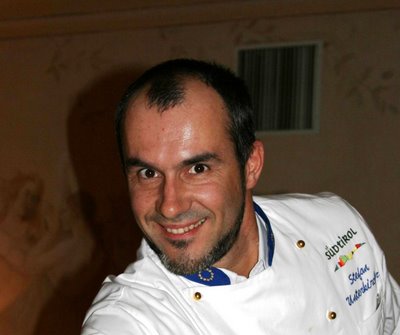 Chef Stefan Unterkircher.
Chef Stefan Unterkircher.
Unterkircher was here to train Polish chefs under an EU programme. If they can deliver this kind of cooking in Poland during my lifetime, I’ll be a very happy man. This was simply excellent food. Simple, flavourful, respectful, exuding experience and freedom at the stoves. Freedom and panache is what Polish chefs most often lack; some have great ideas but just lack the seamlessness that only comes with generations of quality cooking and table service, I think.
Below are my notes on the wines tasted without and with food, as were taken during the dinner.
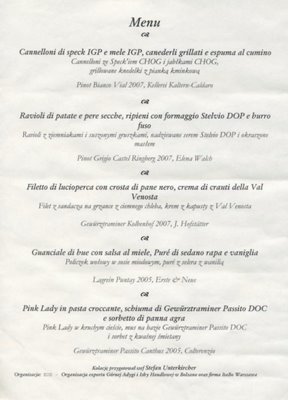
Cantina Produttori Caldaro Pinot Bianco Vial 2007
This is an impressive if really austere, rock-solid, limestoney, dolomitic wine, with a vague soapy character of Pinot Bianco. Acidity is high, there is a rigidity of the 2007 vintage, and on its own it is not showing very friendly.
With cannelloni of IGP speck and IGP apples, grilled dumplings, caraway foam: the tricky part is the featherlight mousse of caraway and gorgonzola, just slightly overpowering the unaromatic Pinot (if a feather can overpower). Good match with the speck-wrapped mild apple, and sufficiently structured (in fact surprisingly so) with the fried canaderlo dumpling.
Elena Walch Pinot Grigio Castel Ringberg 2007
Oaky, rich and butterscotchy, pronounced varietal character but uncomplex at the stage. Palate is rich with a flavour of cereals and baked apple but also a surprising, seary acidity. This has a really odd balance between oak and acids. Not really my style of white, clearly good but a bit heavy-handed without food.
With ravioli of potatoes and dried pears filled with Stelvio DOP cheese and melted butter: Here the acidity is very useful to cut through the beurre noir oxidative richness of the dish. (Take a sip of the above Pinot Bianco to see how tricky this dish is: wine becomes opaque, fruitless and dusty). This Grigio seems almost capable of addressing a wild boar. Impressive match.
J. Hofstätter Gewürztraminer Kolbenhof 2007
A fantastic wine, consistent with several tastings since summer 2008: its usual flowery, exotic self with excellent acidity courtesy of the 2007 vintage. Long, structured, moderately fat for Gewürz, the balance is truly unique: I can’t think of a Traminer this mineral and refreshing.
With fillet of pike perch in black bread crust, creamed Val Venosta cabbage: dish is a little heavy, wine showing high alcohol but otherwise this is a good textural match: very bourgeois and comfy. Interesting counterpoints between the wine’s minerality and flakes of Atlantic sea salt served on the side.
Erste & Neue Lagrein Riserva Puntay 2005
This has the reductive, granitic, wet-basin aromatic austerity of Lagrein, with minor oak in the background. Not a bad wine, with integrated wood and subdued spice. Good acidity, too, and length. Some greenness (as almost all Lagreins in my book). All in all this is very good but perhaps missing the train to excellence.
With beef’s cheek, honey sauce, purée of celeriac and vanilla: An outstanding dish. Very precise cooking with an umami flavour dominating. Match is interesting: bitter cherry core of Lagrein with a hint of caraway matching the obvious spiciness of the dish well, and the wine’s salinity probably the best match for umami.
Cantina Produttori Colterenzio Gewürztraminer Canthus 2007
10.5% alc, 220 g/l sugar. Very varietal, spicy, peppery, with an excellent moment of peach & mango fruit. Even when served quite warm this is never flabby or sticky. Excellent balance. 3.3
With ‘Pink Lady’ apple in French pastry, Gewürztraminer foam, crème fraîche sherbet: As often at gourmet dinners, dessert is the highlight, exuding quality ingredients and a sense of luxure. The sour cream sherbet is a really fantastic match with the similarly rustic, almost animal acidity of the wine. An outstanding combination.
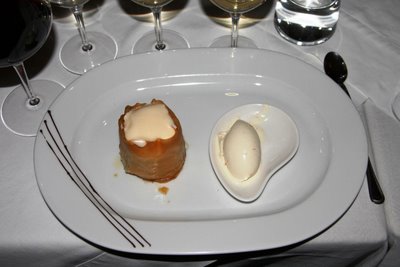 ‘Pink Lady’ apple in French pastry, Gewürztraminer foam, crème fraîche sherbet.
‘Pink Lady’ apple in French pastry, Gewürztraminer foam, crème fraîche sherbet.
An outstanding dessert.
Tomorrow we have a themed tasting of Argentine wines, which already makes me shiver with horror at the amount of oak and extract I’ll need to inhale. Today, we went through an assorted bunch of wines from Italy and France. Among them, the
Domaine Weinbach Alsace Muscat Réserve 2007. Although it’s never been as exciting as the Riesling offerings from this stellar domaine, I expected a lot more from this. It showed very average, losing even to a cheaper Alsatian Muscat from Laurent Barth (which was really, really good). The Weinbach had a faint varietal nose (apples and grapes) over a core of cool stone, and a rather thin palate with a greenish acidity. Better as it warmed up in the glass, revealing a richer medium body and good balance. But still not the expression and cut one associates with the Weinbach name.I took the bottle home to retaste with dinner… and there was obvious TCA (cork taint). Upon opening, it was so minor as to pass unnoticed (even among a half-dozen experienced tasters), but clearly robbed the wine of freshness and complexity. This makes you think of how many faulty wines are assessed as if they weren’t…
The other noteworthy wine of today was the Romano Dal Forno Valpolicella Superiore Monte Lodoletta 2003. Dal Forno is about as high one the Italian wine hypometer as can be, but I dislike his heavy, showy style and interventionist winemaking. Still, given the prices and recognition these wines command, it is also worthwhile to taste them when an occasion arises.
This wine is an amarone in all but name. It smells of prunes, stewed cherries, tobacco, chocolate and spices, and has 15% alcohol. It is to the best of my knowledge made of dried grapes like amarone, and is priced higher than almost all amarones (73€ here in Poland at the current exchange rate). So why call it a Valpolicella? For Dal Forno, it is his ‘second label’ or ‘second selection’ wine: perfect grapes go into his Amarone, and less-than-perfect ones go here. But if you don’t know about this curious policy, you’d be nonplussed by this.
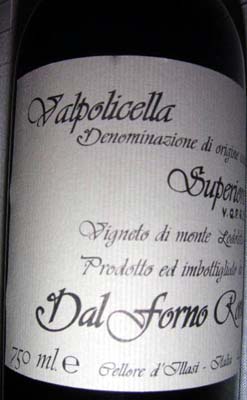
Is this 2003 a good amarone? No. There is far too much extraction and new oak for good balance. The wine smells stewed, tasted stewed and finishes dry-tannic. There is no freshness or finesse, and the fruit is dead. Amarone comes in various guises; I like the more vinous, crisp, less sweet style, and you might like the richer, more powerful one, but balance is the key to success in both. This wine is unbalanced. It tries to impress with its sheer power but goes far too much in the extraction.
Will it ever integrate? We left it in the decanter overnight to see. But predictably, it only got worse. Whatever little freshness of fruit was there upon opening was gone; all that was left was alcohol and oak tannins. Admittedly, it didn’t oxidise even with 18 hours in the decanter. But there was no drinking pleasure. Even the label drinkers among us were skeptical.
All these appellations are quite small: Gattinara today is down to only 95 hectares (historically it was perhaps four times that), Ghemme has 50 registered hectares. In the past wines were produced either by medium-sized aristocratic estates – sort of châteaux – or, more often, blended by small local négociants that offered a couple of labels from each zone. Yields are low, vineyard work costs very high, the wines were often aged in wood and bottle for 6–7 years: a big investment that was often beyond the means of the small farmers. Today négociants are less important, and the best wines are made by medium-sized private estates such as Travaglini and Nervi (in Gattinara), Le Piane (Boca), the new Proprietà Sperino (Lessona), and Antichi Vigneti di Cantalupo in Ghemme.
Cantalupo is a veteran of the Upper Piedmont, having been making good wines since at least the 1960s. Apart from the flagship Ghemme there is a number of interesting labels, including Il Mimo, a rosé Nebbiolo that’s one of Italy’s most exciting, the good white Carolus (which includes a splash of the ultra-rare Greco di Ghemme grape), and Villa Horta, a rare 100% Vespolina (a light, perfumed red grape added to soften harsh Nebbiolo tannins).
At the top of the pyramid we have three crus of Ghemme: Carellae, Breclemae and Signore di Bayard (the only wine here to see small oak, whose is generally discouraged in this district). I have cellared the Ghemme Collis Breclemae 1998 since release, and expected it to be maturing now. But it isn’t – courtesy of the cool 1998 vintage perhaps, but also of the excellent mineral structure of this wine. Colour is a Nebbiolo lightish ruby but no signs of tiring. Nose at first reticent, needs at least 30 minutes’ airing time in glass. A core of clean semi-aged strawberry fruit, melting into an almost chocolatey richness (from maturity, not oak). Not very complex at first but there is not a hint of tertiary character. Palate is really very good, long, fresh and tasty but not particularly acidic. Tannins on finish are firm, and increasingly so with airing time. This wine has poise and stature; it is not austere, but doesn’t give itself away in modernist flatter; it is fresh, authentic, linear and engaging. Overall an excellent bottle, and can / should still wait.
Long underdeveloped, Sicilian wines are gathering momentum. But few of the whites are exciting. Here’s the best of them all, made from the local Grillo grape.